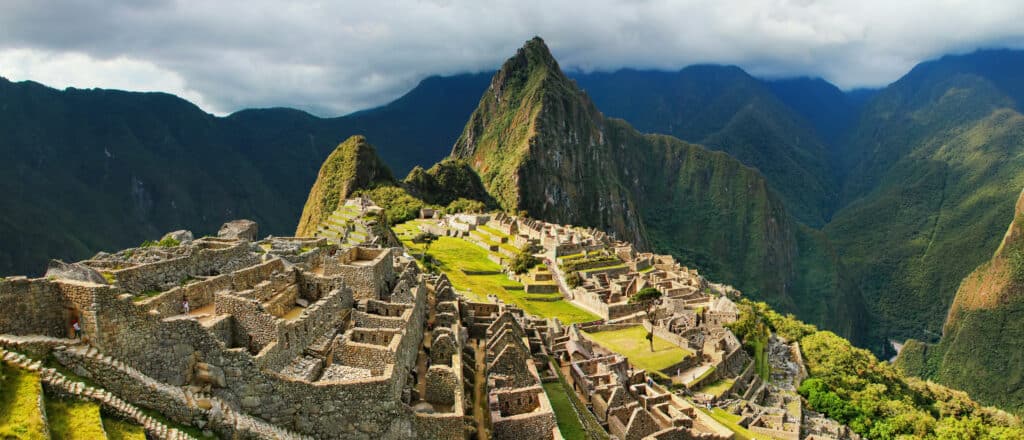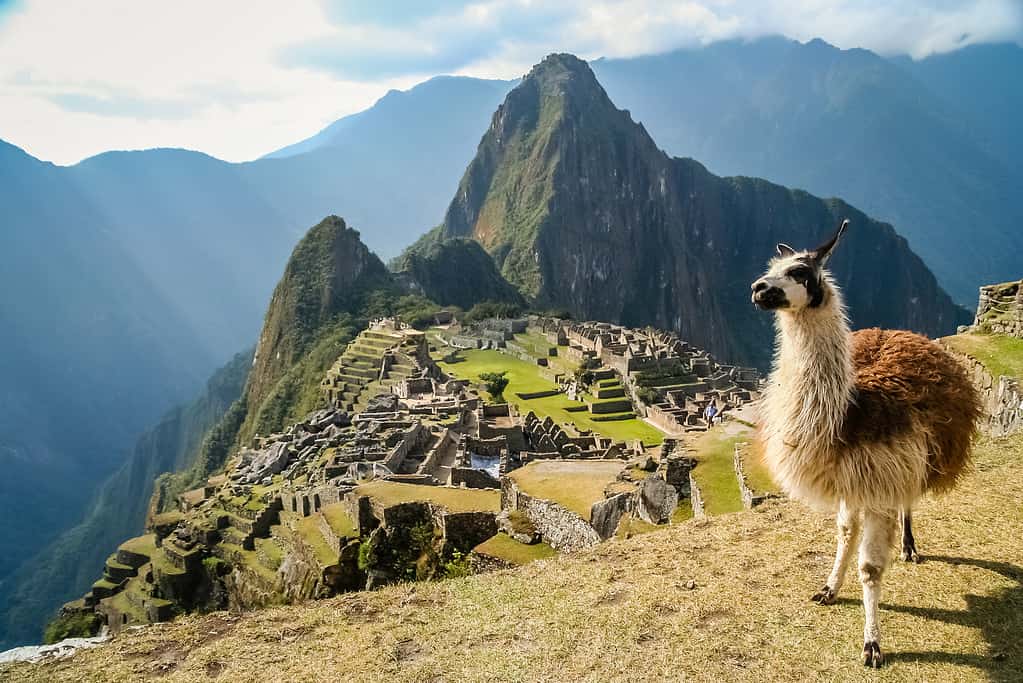There are many wonders in this world. Some of them are natural and some of them are man-made. Machu Picchu in Peru is one of those man-made wonders that has left people in awe. It is a 15th-century Incan civilization citadel that has been visited by millions of people for centuries.
People post selfies with the citadel in the background. They go to the edge of the citadel to witness the magnificence of the green-covered Andes and the Urubamba River. But many have no idea how and when Machu Picchu was built in the first place. Most people don’t know the history behind the Incan citadel, and how, almost 600 years ago, it was built becoming a symbol of the strength, perseverance, and grandiosity of the Incan Empire.
Let’s explore how and when the Machu Picchu was built. We’ll also give you some information on the wildlife in the area, and some things to do in Peru.
Location of Machu Picchu

Machu Picchu is the most visited place in Peru, with 2,500 visitors every day.
©Don Mammoser/Shutterstock.com
Machu Picchu is located on top of a mountain (7,970 feet above sea level) in the Eastern Cordillera, in Southern Peru. It is the most popular landmark of the Incan Empire and it sometimes has been called the “Lost City of the Incas.” About 50 miles from Cusco, you will find yourself in the Urubamba Province and more specifically in the Machupicchu District.
Machu Pichu has views of the Andes where the Urubamba River flows below the citadel. In the Quechua language, Machu means “old” and Picchu means “cone or pyramid,” thus Machu Picchu means old pyramid.
There are two ways to get to Machu Picchu. You can go on the famous Inca Trail starting in Chillca, which will take four days to accomplish. The other option is taking a train. The train will depart from Cuzco, taking approximately three and a half hours. Or you can take the train from Ollantaytambo and it will take a brisk one and a half. The train will go past the Urubamba River and the “Sacred Valley.” You then will trek up to Machu Picchu, but the climb won’t be as arduous as the Inca Trail trek.
History of Machu Picchu

Peru is where the Incan civilization began before they spread throughout Latin America.
©Uwe-Bergwitz/iStock via Getty Images
It is believed, according to Anthropology Professor Richard L. Burger of Yale University that Machu Picchu was built around 1420. Construction happened around the time that Pachacutec Inca Yupanqui and Túpac Inca Yupanqui were the rulers of the Incan Empire.
The real reason for the construction of this citadel is unknown, as the Incas had no written language. What archeologists believe, however, is that Machu Picchu was built when the Inca ruler Pachacutec ordered a royal estate to be built and it would be used as a retreat. The citadel was built with dry-stone walls in the Incan style. There are three major structures at Machu Picchu — the Intihuatana, the Temple of the Three Windows, and the Temple of the Sun.
It is also believed that the Incas abandoned Machu Picchu when the Spanish came to Peru and started conquering their lands. There is another hypothesis that many Incas died of European diseases like smallpox well before the Spanish conquerors arrived in the Machu Picchu area. It was Spanish conquistador Baltasar Ocampo who first saw the citadel after that, no other people visited the site for more than 300 years.
It wasn’t until 1911 that American explorer Hiram Bingham visited Machu Picchu and “rediscovered” the citadel, ensuring that everyone found out about the “Lost City of the Incas.” After the “rediscovery,” major excavations took place to uncover the Incan citadel and over the past century, Macchu Picchu has slowly been restored to what it would have looked like in 1450.
Wildlife in the Area

There are more than 72 languages spoken in Peru. However, its official languages are Spanish, Quechua, Aymara, and a few other Indigenous languages.
©pawopa3336/iStock via Getty Images
Peru is one of the most biodiverse countries in the world. As such, you will be able to see a lot of animals as you take the train to Macchu Picchu (or hike the Inca Trail). After all, Machu Picchu is nestled in the Andes Mountains and borders the Urubamba River.
In the broad sense, there are about 700 species of butterflies and more than 400 species of birds. There are also more than 50 species of mammals, a dozen species of fish, and about a hundred species of spiders.
But what are the animals and creatures you can spot on that hike up to the Incan citadel? The most common animals you can spot are the condor, puma, and the spectacled bear, which happens to be on the endangered list. Of course, you are bound to run into four species of Andean camelids — otherwise known as llamas, alpacas, guanacos, or vicuñas.
Things to Do in Peru

Peru has a population of 34.3 million and its capital, Lima, is the largest city with 8.5 million people.
©SCStock/iStock via Getty Images
Machu Picchu is just one historical sight that is worth visiting in Peru. But there are a lot of things to do in the country, too. Located in South America, Peru is a country with a lot of history that spans thousands of years. You will learn about the meaning of life, but you will also learn about the rich, cultural heritage of Peruvians. Moreover, the natural landscapes of the country do not compare to many others.
For those history and culture lovers out there, you have to start your visit to Peru in the nation’s capital. The coastal city of Lima is an enchantment of a place. The Spanish architectural buildings all around you will transport you to a time when everyone was dressed in suits and ties and fancy dresses.
The Lima Cathedral, built over 195 years between 1602 and 1797, is a beautiful building with splashes of Baroque, Neoclassical, and even Gothic architecture. To learn about Peru’s Indigenous cultures, go to the Museo de la Nación. Finally, complete your learned experiences by going to the Larco Museum for pre-Columbian art.
Nature lovers have endless possibilities in Peru. You can head to Colca Canyon for stunning views. Colca Canyon is situated near the Colca River. You also have to go to Lake Titicaca, the highest navigable lake in the world. Lastly, the city of Cuzco and, of course, Machu Picchu, are must-sees to make your Peruvian cultural experience complete.
Fast Facts About Peru
- Capital: Lima
- Population: 34.3 million
- Area: 496,225 square miles
- Official Languages: Spanish (official), Co-official: Quechua, Aymara, and other indigenous languages
- President: Dina Boluarte
- Prime Minister: Alberto Otárola
- Independence Declared: July 28, 1821
Conclusion
And there you have it, that’s how and when Machu Picchu was built. The ancient Incan citadel is Peru’s prized jewel. Archeologists and historians have learned so much about the Inca civilization and their amazing accomplishments by studying the citadel and the artifacts found there. UNESCO named Machu Picchu a World Heritage Site in 1983. It is considered one of the new Seven Wonders of the World for a reason.
So, as you take the Inca Trail up to Machu Picchu with the help of coca leaf tea, think about the history, think about the people, and think about the important events that happened on the mountain you’re gradually climbing.
The history of Machu Picchu is unique and amazing. After almost 600 years, we have been given the privilege to see into the lives of a great empire that shaped the history of Latin America. The Incas were a powerful civilization that gave so much to society and we must learn about them and their contributions.
Thank you for reading! Have some feedback for us? Contact the AZ Animals editorial team.








